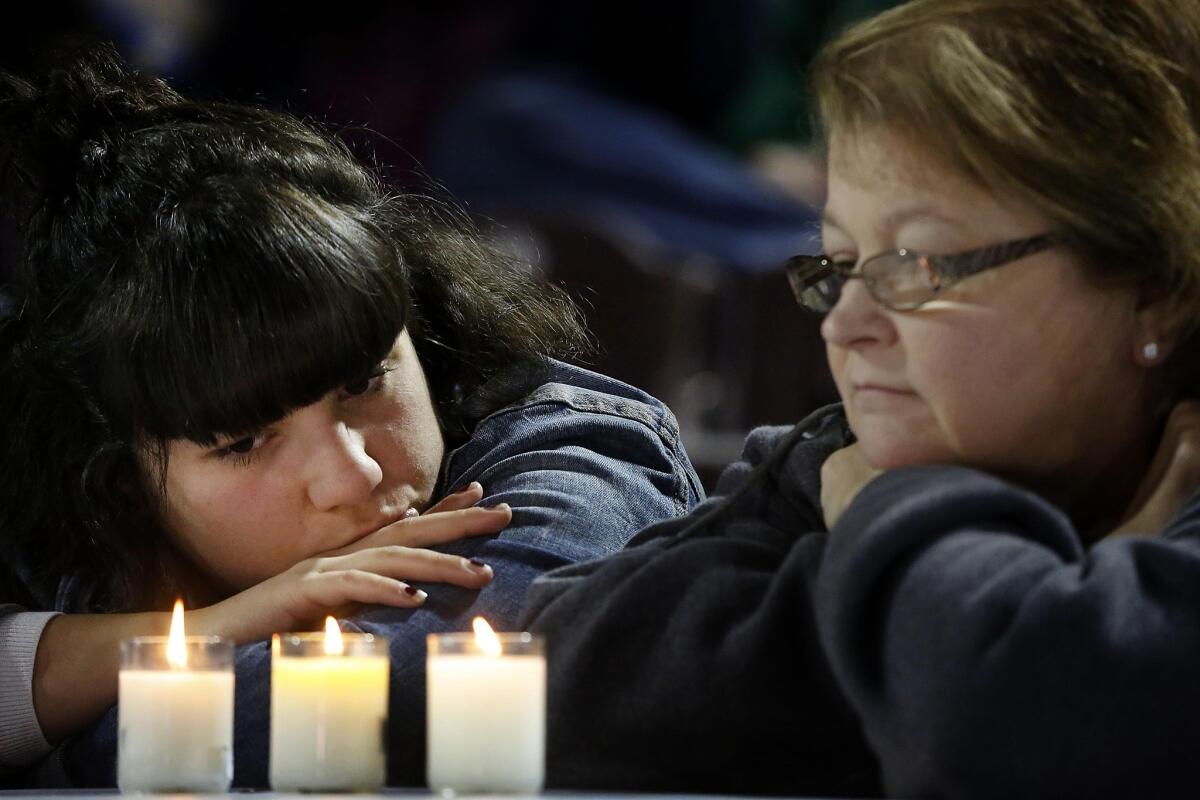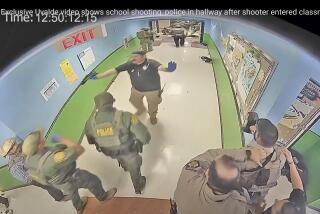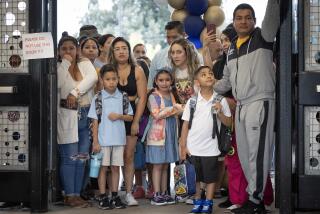How to talk to your kids about the San Bernardino shootings

A vigil for shooting victims in San Bernardino. Parents should look for any changes in their kidsâ behavior that indicate stress.
There are about 50,000 students in the San Bernardino City Unified School District, and even more in the surrounding cities. Many of those students spent the latter half of Wednesday on lockdown; some were in school close to the Inland Regional Center, where a mass shooting left 14 people dead and 21 wounded.
Parents struggling to make sense of a traumatizing situation themselves must now help their children cope. âEven as adults we donât understand fully what took place and why,â said Brett Nelson, a Cal State San Bernardino professor and the coordinator of the universityâs school psychology program.
Here are tips from Nelson and other experts in San Bernardino about how to talk about the shooting with your children.
1. Assure them that theyâre safe
This is the most important step, experts say, and the one to take first.
â[Kids are] anxious and worried, and theyâre dealing with the unknown,â Nelson said. âParents have to be role models in terms of establishing a sense of safety, security, predictability.â Kids who feel unsafe can have a hard time concentrating, or can become anxious and more afraid, which is why parents should let children talk about their concerns.
2. Guide them through the news
Nelsonâs son and daughter, ages 9 and 11, wanted to watch the news on Wednesday night. Nelson let them, but made sure to watch it with them and explain complicated topics and help them navigate news sources. âWe guide them and we were there with them,â he said.
One way or another, students are going to hear about current events, and they are often misinformed by rumors. Allowing your kid to watch, listen to, or read the news with you lets you filter the information they take in.
3. Use age-appropriate language
Introducing concepts that are too complex can make a situation more confusing and scarier for children. The National Assn. of School Psychologists developed guidelines for explaining violent events to kids of different ages, and San Bernardino City Unified issued tips to their teachers Thursday on how to talk to kids.
Follow live coverage of the San Bernardino shooting >>
If children have specific questions, parents should answer them to make sure they have accurate information.
From the NASP tip sheet:
- âEarly elementary school children need brief, simple information that should be balanced with reassurances that their school and homes are safe and that adults are there to protect them.â
- âUpper elementary and early middle school children will be more vocal in asking questions about whether they truly are safe and what is being done at their school. They may need assistance separating reality from fantasy. Discuss efforts of school and community leaders to provide safe schools.â
- âUpper middle school and high school students will have strong and varying opinions about the causes of violence in schools and societyâŚ. Emphasize the role that students have in maintaining safe schools by following school safety guidelines ... communicating any personal safety concerns to school administrators, and accessing support for emotional needs.â
4. Know that theyâre watching you
âWe donât realize what our kids pick up from us,â Nelson said. âThey are listening to everything we say and they are watching everything we do.â
Children mirror their parentsâ words and behaviors â so make sure to remain calm when talking to them or discussing a situation in front of them. Avoid oversimplified or hyperbolic statements, such as blaming a group of people for the shooting before authorities have confirmed the motives.
5. Have a family plan
âAny preparation is a safety net, it makes people feel secure,â said Laura Strachan, the San Bernardino City Unified School Districtâs director of alternative programs. If parents devise a plan for the family in case of emergencies â whom to call, where to meet, how to convey messages â children will know their parents are in control.
6. Maintain a routine
Attendance was lower than usual in the school district on Thursday, according to preliminary figures. While itâs understandable that parents would want to keep kids home after the shooting, especially if it occurred close to home or affected the family, routine can help students feel safe, Nelson said.
School counselors and members of the school districtâs crisis team will be available for students and staff Friday, so it could be beneficial for parents to bring their kids to school. Counselors can talk to students about coping strategies, how to talk about their feelings, or getting back to their normal routines, said Lorinda Ordaz, a member of the districtâs crisis response team.
7. Watch them over time
Nelsonâs kids were fighting Wednesday night for no reason. That might be normal sibling behavior, or it might be their anxiety. Parents should look for any changes in their kidsâ behavior that indicate stress. That can include anxiety or changes in eating habits, headaches, stomachaches or complaining more, according to Ordaz.
Moments like this can also exacerbate other trauma that a child faces. The resulting change in behavior could come any time over the next few weeks, Strachan said. If kids are more fearful or anxious, remind them that theyâre safe, and tell the teacher or school counselor.
Follow live coverage of the San Bernardino shooting >>
Reach Sonali Kohli on Twitter @Sonali_Kohli or by email at [email protected].
MORE ON SAN BERNARDINO SHOOTING
Rampage killers led secret life, hiding plans and weapons
Feds probe possible terrorism links in San Bernardino massacre
For victimâs boyfriend, 22 hours of conflicting reports, then heartbreak
More to Read
Sign up for Essential California
The most important California stories and recommendations in your inbox every morning.
You may occasionally receive promotional content from the Los Angeles Times.











